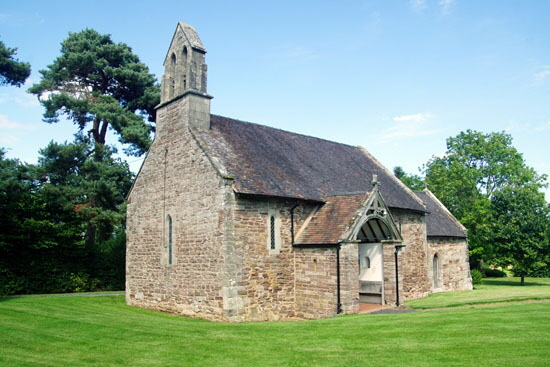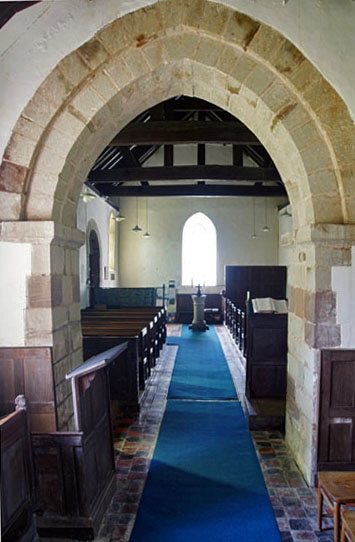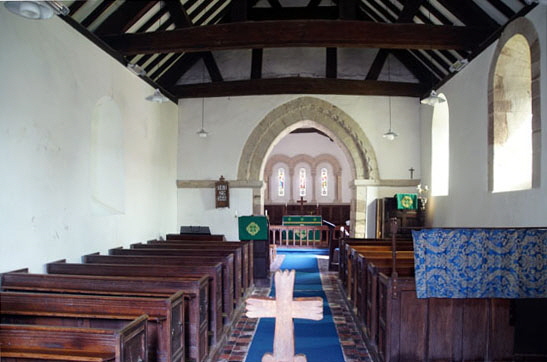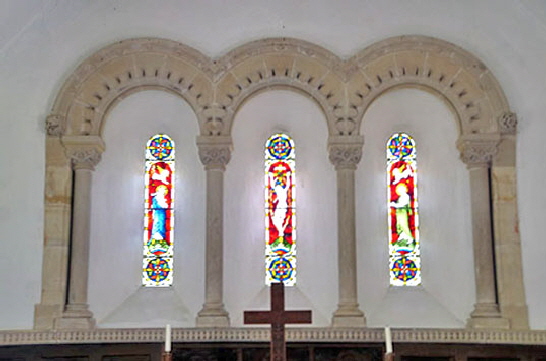|
|
||||||||||||||||||||||||||||||||||||||||||||||||||||||||||
|
Please sign my Guestbook and leave feedback |
||||||||||||||||||||||||||||||||||||||||||||||||||||||||||
|
Recent Additions |
||||||||||||||||||||||||||||||||||||||||||||||||||||||||||
 |
 |
|||||||||||||||||
|
Left: The church from the south east. It is one of those rarities where there is not a single window with tracery. A church this size cannot bear gothic windows but sadly that has not prevented that happening at innumerable other tiny churches. The three Norman style lancets at the east end are Victorian. The pointed arches of the south chancel windows and the priest’s door - along with the Transitional chancel arch - suggest that this was originally a single celled church. Right: The church from the south west. The porch is a blessing and has protected the tympanum from the ravages of the weather. |
||||||||||||||||||
 |
||||||||||||||||||
 |
 |
|||||||||||||||||
|
Left: The south doorway and its impressive tympanum. Apart from the tympanum itself this is an unsophisticated Norman doorway. Centre: Looking east through the Transitional arch to the chancel with its pretty faux-Norman east windows. Right: The view west through the chancel arch. |
||||||||||||||||||
 |
||||||||||||||||||
|
The tympanum. It is exceptionally fine and - by no means common in Norman tympanum carving - well-composed. But is it by the Herefordshire School? On the whole I think that it isn’t. Mainly I think that it isn’t because Malcolm Thurlby who has written the definitive work on this subject - “The Herefordshire School of Romanesque Sculpture” - doesn’t include it. That might seem a bit uncharacteristically wimpish on my part. Thurlby’s book, however, examines the subject so thoroughly and with such authority that I feel it is for those who would have the tympanum as being by one of the Herefordshire School then I think it is for the proponents to advance arguments to that effect. Its being in the proximity of indisputable work by the School and being of a similar high quality simply won’t do. Its promoters go as far as to suggest it was the “Shobdon Master” that carved it. We shall be seeing Shobdon later on this trail. There are two tympani at Shobdon, both unfortunately located where weathering has taken a heavy toll. One of these - the “Harrowing of Hell” - does seem to me from older pictures to be stylistically reminiscent of the Aston Eyre tympanum, The naturalistic figures and the folds of the robes are similar. Both are of the highest quality. To set against this, Shobdon’s is a whole scheme of decoration of the most elaborate kind, with fantastic designs to columns and arches. The Aston Eyre tympanum stands almost alone with only two very restrained and everyday carvings on the capitals. More significantly, however, Thurlby was able to connect the Hereford School work via the men who were its patrons: the likes of Olivier de Merlimond and the Baskerville and de Lacy families. None of these men appear in the history of the Aston Eyre church. It could be the work of the Shobdon Master. My own work on the Mooning Men Lodge in the fifteenth century East Midlands demonstrated that masons can crop up in unexpected places and that their work was often inconsistent. It is the patronage dimension that for me, however, makes me on the whole a wee bit sceptical. There just isn’t quite enough counter-argument for my money. |
||||||||||||||||||
 |
||||||||||||||||||
 |
||||||||||||||||||
|
Left: The faux-Norman eastern window composition. Right: Another view to the west end showing the deeply-splayed Norman window spaces. |
||||||||||||||||||